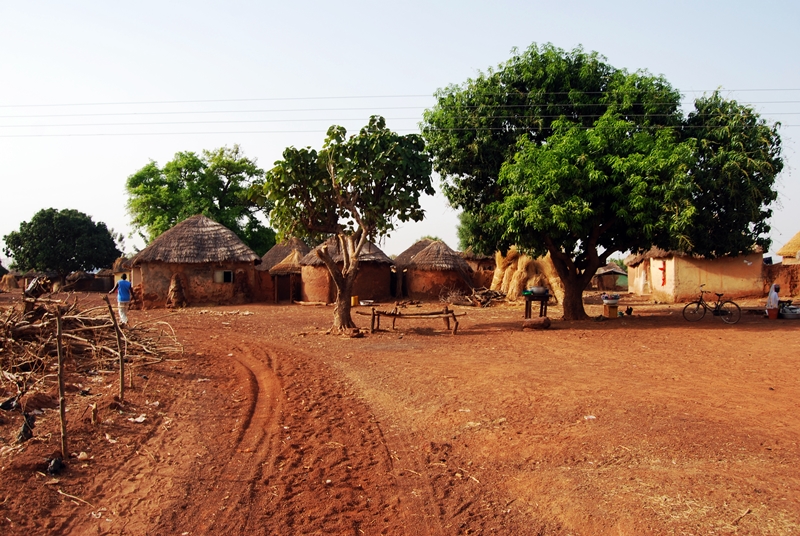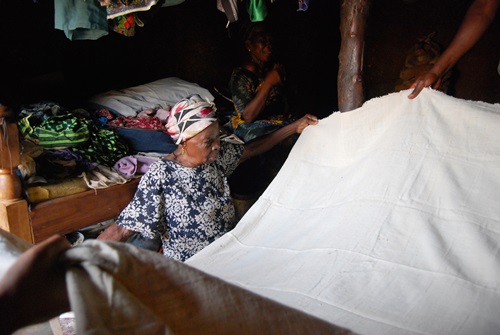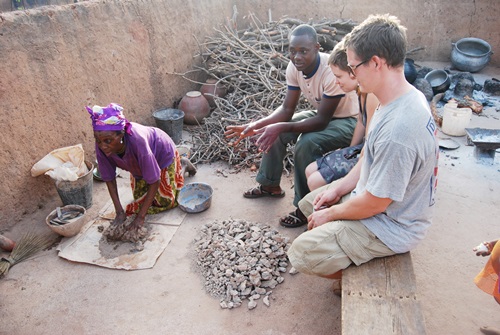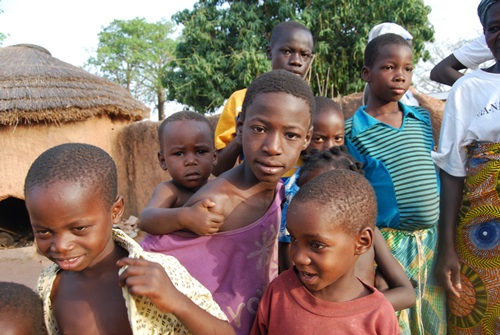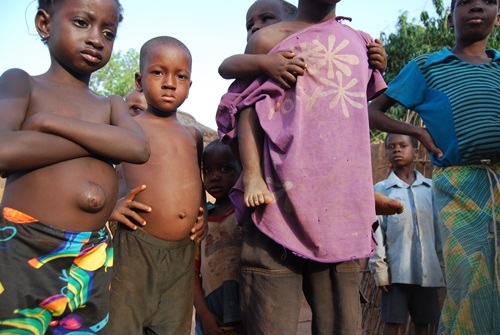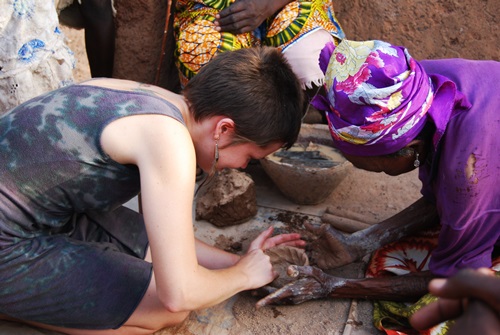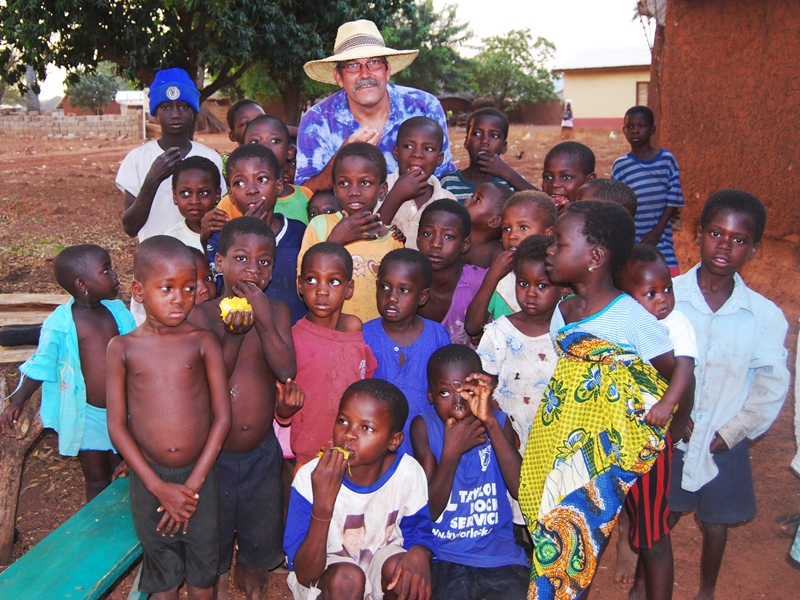A introduction to some traditional Dagomba cultural practices – shea butter, cotton and pottery, Oh my!
Bob, Amy and Jeremy get a hands-on tour of Mbanayili village on February 22, 2013. We had a great time, and left some tourist dollars at the very local level.
A STEP BACK IN TIME
The entrance to Mbanayili at rush hour. Welcome to Savannaland!
CALABASHES!


In the center of the village stands a calabash tree (Crescentia cujete) useful for so many purposes – bowls, animal fodder, and medicine.
WOMAN POWERED BUSINESS

We first visited the village’s shea nut (Vitellaria paradoxa) processing plant, and they’re not messing around. These women collect the nuts, dehull them, have them crushed at the cooperative crusher, then they render out the shea butter.
IT TAKES A FEW WOMEN – NOT THE WHOLE VILLAGE


And a least one man – the mechanic.
KEEPING THE EQUIPMENT SPINNING


As we arrived at the crusher, the mechanic/operator was just getting it adjusted for the next run.
NUTS!


The ladies bring the hulled nuts in in headpans, and wait their turn to have their nuts crushed – they are not commingled with others lots. On the left you can see one lady feeding in her batch and another lady returning the crushed nuts to one of her headpans.
INFRASTUCTURE


Two different technologies – the nicely built and painted shea nut processing facility and the easily procured and erected traditional tree enclosure (?)
DON’T CUT THE TREE THAT FEEDS YOU


Shea trees grow wild in the savanna and many of the nuts are wild harvested by the lady who picks that day’s nuts off the ground. The nuts are not picked from trees as they have to mature enough to fall in order to be ready for shea butter processing. After finishing looking at the butter process, our village guide Abu took us to visit the compound of a lady who spins thread from locally grown cotton.
PATIENCE REQUIRED


The Spinner started with cotton picked from the plant. She removed the seeds, and then pulled the cotton ball in her hand to align the fibers. Next she “fluffed” the fibers with the bow and stick, tapping on the string to “pluck” it and working it through the fluff of cotton. Next she wound the cotton around a stick just like cotton candy.
SPINNING LIKE A TOP
Her tools were simple, but her results were efficient and beautiful. She used a small stick with a round weight on the end like a top to spin the fibers while she continued to feed more cotton in. A calabash shell was used to keep the spinner top contained as well as to contain the residual fire roasted and pulverized cow bone powder that helps whiten the thread and resultant cloth. On the right you can see a cloth made from her thread. This will be her burial cloth. We were told that the custom in the village was for old folks to have their burial shroud ready.
COMPOUNDS ARE COOL


Compounds provide security for the family. They are built by adding a square hut for the man, and a round room for his wife. They are added onto as a family grows. They are cool inside and have some cool people living in them. Here’s Amy and Jeremy with the Spinner lady who wanted us to have a picture with her outside her front door. Spending half an hour in her hut was *very* cool.
THERE WILL BE MUD
Our next stop was at a lady who made pottery. Again, our guide Abu translated for us and gave us details of the processes and uses of the vessels. The Potter mixed water with clay she had dug near the village, as well as some crushed up broken pottery for strength.
THE HANDS TELL THE STORY


Like the Spinner, the Potter’s hands were sculpted by the work.
IT’S EASY WHEN YOU KNOW HOW


The Potter sowed us how she makes pots and then offered to have one of us try, just like the Spinner did (none us us took the Spinner up on the offer).
IT’S ALL IN THE WRIST
She made it look easy. Lots of the local kids gathered round to watch the obronis watch her work.
IT’S EASY WHEN YOU KNOW HOW 2.0
Amy jumped in and gave the pot making a go. She had made a pot by the same method in Asheville last year. You can see the delight on the Potters face as she watches Amy’s hands tentatively working the trade she’s known for so many years.
FINISHING TOUCHES
As the Potter guided Amy to a successful pot, the crowd broke into applause and laughter.
FINISHED PRODUCT


Here’s a couple of pots the Potter made, these are probably destined to be decorative flower pots in Tamale. On the right, a lady was preparing dinner as we all watched the Potter’s process in the courtyard of the Potter’s compound.
PIED PIPER
As the sun was setting on an unforgettable experience, Bob led an impromptu workshop on different whistling techniques. The kids were delighted by the shrill “fingers in the mouth” whistle and gave it a try for the camera. We would highly recommend this tour for anyone visiting Northern Ghana. Look up “Walisu” in “Tamale” on the internets – he’ll be happy to hook you up!
____________________________________________________________
[Latest] * [Troutsfarm] * [Green Ranch] * [FS2BD February] * [Journey to Asempa] * [Mole National Park] * [First Two Safaris] * [Final Safari] * [Meeting Savannah Plants] * [Mbanayili Village] * [Tamale]
____________________________________________________________
